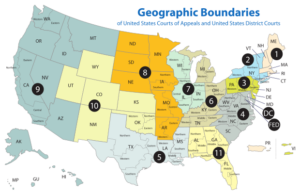The United States federal court system is a hierarchical structure consisting of three levels: the district courts, the courts of appeals, and the Supreme Court. District courts are trial-level courts who have jurisdiction over a wide range of federal cases, including criminal cases, civil cases involving federal law, and cases involving federal agencies. The courts of appeals are intermediate appellate courts, who hear appeals from the district courts and other federal agencies within their geographic jurisdiction. The Supreme Court is the highest court in the United States, and has the final say on all cases involving federal law and the United States Constitution.
 The federal court system was established by the Constitution, which gives Congress the power to create and regulate federal courts. Our first federal courts were created by the Judiciary Act of 1789, which only established district courts and the Supreme Court. The Act also created the Office of the Attorney General and provided for the appointment of federal judges by the President, with the advice and consent of the Senate.
The federal court system was established by the Constitution, which gives Congress the power to create and regulate federal courts. Our first federal courts were created by the Judiciary Act of 1789, which only established district courts and the Supreme Court. The Act also created the Office of the Attorney General and provided for the appointment of federal judges by the President, with the advice and consent of the Senate.
Over time, the federal court system has evolved and expanded to meet our country’s changing needs. The number of federal district courts and judges has increased while new courts of appeals have been established.
The United States Court of Appeals for the Seventh Circuit (in case citations, 7th Cir.) is a federal court with appellate jurisdiction over the district courts for the following districts:
- Central District of Illinois
- Northern District of Illinois
- Southern District of Illinois
- Northern District of Indiana
- Southern District of Indiana
- Eastern District of Wisconsin
- Western District of Wisconsin
The court is based at the Dirksen Federal Building in Chicago and is composed of eleven appellate judges.
Here are some landmark cases decided in the Seventh Circuit:
- Bowers v. Hardwick (1986) – upheld a Georgia law that criminalized homosexual acts. The Supreme Court later overturned this decision in Lawrence v. Texas (2003).
- United States v. Watson (1976) – established the “exigent circumstances” exception to the Fourth Amendment’s warrant requirement, allowing law enforcement to make warrantless arrests in emergency situations.
- Ashcroft v. American Civil Liberties Union (2004) – held that the Child Online Protection Act violated the First Amendment by restricting access to material on the Internet that is harmful to minors.
- United States v. Skoien (2010) – upheld the constitutionality of the federal ban on possession of firearms by persons convicted of a misdemeanor crime of domestic violence.
- Wisconsin Right to Life, Inc. v. Federal Election Commission (2007) – held that certain provisions of the Bipartisan Campaign Reform Act were unconstitutional restrictions on political speech.
These cases reflect the Seventh Circuit’s role in addressing a wide range of legal issues, including civil rights, criminal procedure, and First Amendment rights.